Choice of ATP Analogues for Biophysical Studies—A Systematic NMR-Based Investigation for the AAA Enzyme p97
Abstract
:1. Introduction
1.1. Why Nucleotide Analogues?
1.2. Why Scrutinise Results Obtained Using Analogues?
- At the active site, the binding sites and poses of ATP and Mg2+ ions can be altered, even by subtle synthetic modifications, such as thiophosphate substitution [15]. Changes in nucleotide–ion or nucleotide–protein contacts can affect binding affinity.
- Due to non-native binding modes at the active site, long-range conformational changes associated with ATP binding and hydrolysis may not be accurately replicated, leading to misrepresentations of the overall protein conformational space.
- The nucleotide bound at the active site can be different to the one supplied in solution. Indeed, not only ATP but also slowly hydrolysable analogues may inadvertently trap enzymes in post-hydrolysis states in which product release, not hydrolysis, is rate-limiting.
- Analogues differ from ATP in thermal and chemical stability and compatibility with ATP-regeneration systems for multiple-turnover experiments.
1.3. Setup and Goals of This Study
2. Materials and Methods
2.1. Source of Nucleotide Analogues
2.2. Protein Expression and Purification
2.3. NMR Sample Preparation
2.4. NMR Measurements
3. Results
3.1. Stability of Nucleotide Analogues in Solution
3.1.1. Hydrolysis-Resistant ATP Analogues
3.1.2. α/β-Thiosubstituted ATP Analogues
3.2. Protein Conformation Induced by Nucleotide Analogues
3.2.1. ATPγS
3.2.2. α/β-Thiosubstituted ATP Analogues
3.2.3. Hydrolysis-Resistant ATP Analogues
3.3. Nucleotide Detection by 31P NMR in the Protein Sediment
3.3.1. Detection of Unbound Nucleotides via Directly Pulsed 31P NMR
3.3.2. Detection of Protein-Bound Nucleotides Through 1H-31P-CP
3.4. Nucleotide Detection by 19F NMR in Solution
4. Discussion
Author Contributions
Funding
Data Availability Statement
Acknowledgments
Conflicts of Interest
Abbreviations
| ATP | Adenosine 5′-triphosphate |
| ADP | Adenosine 5′-diphosphate |
| AMP | Adenosine 5′-monophosphate |
| PEP | 2-Phosphoenolpyruvate |
| PK | Pyruvate kinase |
| MAS | Magic-angle spinning |
| NMR | Nuclear magnetic resonance |
| ssNMR | Solid-state NMR |
| AAA+ | ATPases Associated with diverse cellular activities |
| TCEP | Tris(2-carboxyethyl)phosphine |
| HEPES | (4-(2-Hydroxyethyl)-1-piperazineethanesulfonic acid) |
| NTD | N-terminal domain |
| CP | Cross-polarisation |
| CSA | Chemical shift anisotropy |
| HMQC | Heteronuclear multiple quantum coherence |
| TROSY | Transverse relaxation-optimised spectroscopy |
References
- Beis, I.; Newsholme, E.A. The contents of adenine nucleotides, phosphagens and some glycolytic intermediates in resting muscles from vertebrates and invertebrates. Biochem. J. 1975, 152, 23–32. [Google Scholar] [CrossRef] [PubMed]
- Romani, A.M. Cellular magnesium homeostasis. Arch. Biochem. Biophys. 2011, 512, 1–23. [Google Scholar] [CrossRef] [PubMed]
- Mudryk, K.; Lee, C.; Tomanik, L.; Malerz, S.; Trinter, F.; Hergenhahn, U.; Neumark, D.M.; Slavicek, P.; Bradforth, S.; Winter, B. How Does Mg2+(aq) Interact with ATP(aq)? Biomolecular Structure through the Lens of Liquid-Jet Photoemission Spectroscopy. J. Am. Chem. Soc. 2024, 146, 16062–16075. [Google Scholar] [CrossRef] [PubMed]
- Goody, R.S.; Eckstein, F. Thiophosphate analogs of nucleoside di- and triphosphates. J. Am. Chem. Soc. 1971, 93, 6252–6257. [Google Scholar] [CrossRef]
- Yount, R.G.; Babcock, D.; Ballantyne, W.; Ojala, D. Adenylyl imidodiphosphate, an adenosine triphosphate analog containing a P--N--P linkage. Biochemistry 1971, 10, 2484–2489. [Google Scholar] [CrossRef]
- Eckstein, F. Investigation of enzyme mechanisms with nucleoside phosphorothioates. Angew. Chem. Int. Ed. Engl. 1975, 14, 160–166. [Google Scholar] [CrossRef]
- Bagshaw, C. ATP analogues at a glance. J. Cell Sci. 2001, 114, 459–460. [Google Scholar] [CrossRef]
- Baranowski, M.R.; Nowicka, A.; Rydzik, A.M.; Warminski, M.; Kasprzyk, R.; Wojtczak, B.A.; Wojcik, J.; Claridge, T.D.; Kowalska, J.; Jemielity, J. Synthesis of fluorophosphate nucleotide analogues and their characterization as tools for 19F NMR studies. J. Org. Chem. 2015, 80, 3982–3997. [Google Scholar] [CrossRef]
- Ono, T.; Scalf, M.; Smith, L.M. 2′-Fluoro modified nucleic acids: Polymerase-directed synthesis, properties and stability to analysis by matrix-assisted laser desorption/ionization mass spectrometry. Nucleic Acids Res. 1997, 25, 4581–4588. [Google Scholar] [CrossRef]
- Juen, F.; Glanzer, D.; Plangger, R.; Kugler, V.; Fleischmann, J.; Stefan, E.; Case, D.A.; Kovacs, H.; Kwaku Dayie, T.; Kreutz, C. Enhanced TROSY Effect in [2-19F, 2-13C] Adenosine and ATP Analogs Facilitates NMR Spectroscopy of Very Large Biological RNAs in Solution. Angew. Chem. Int. Ed. Engl. 2024, 63, e202316273. [Google Scholar] [CrossRef]
- Lacabanne, D.; Wiegand, T.; Wili, N.; Kozlova, M.I.; Cadalbert, R.; Klose, D.; Mulkidjanian, A.Y.; Meier, B.H.; Bockmann, A. ATP Analogues for Structural Investigations: Case Studies of a DnaB Helicase and an ABC Transporter. Molecules 2020, 25, 5268. [Google Scholar] [CrossRef] [PubMed]
- Rodriguez-Aliaga, P.; Ramirez, L.; Kim, F.; Bustamante, C.; Martin, A. Substrate-translocating loops regulate mechanochemical coupling and power production in AAA+ protease ClpXP. Nat. Struct. Mol. Biol. 2016, 23, 974–981. [Google Scholar] [CrossRef] [PubMed]
- Rydzek, S.; Shein, M.; Bielytskyi, P.; Schutz, A.K. Observation of a Transient Reaction Intermediate Illuminates the Mechanochemical Cycle of the AAA-ATPase p97. J. Am. Chem. Soc. 2020, 142, 14472–14480. [Google Scholar] [CrossRef] [PubMed]
- Shein, M.; Hitzenberger, M.; Cheng, T.C.; Rout, S.R.; Leitl, K.D.; Sato, Y.; Zacharias, M.; Sakata, E.; Schutz, A.K. Characterizing ATP processing by the AAA+ protein p97 at the atomic level. Nat. Chem. 2024, 16, 363–372. [Google Scholar] [CrossRef]
- Jaffe, E.K.; Cohn, M. Divalent cation-dependent stereospecificity of adenosine 5‘-O-(2-thiotriphosphate) in the hexokinase and pyruvate kinase reactions. The absolute stereochemistry of the diastereoisomers of adenosine 5‘-O-(2-thiotriphosphate). J. Biol. Chem. 1978, 253, 4823–4825. [Google Scholar] [CrossRef]
- Matlahov, I.; van der Wel, P.C.A. Hidden motions and motion-induced invisibility: Dynamics-based spectral editing in solid-state NMR. Methods 2018, 148, 123–135. [Google Scholar] [CrossRef]
- Siemer, A.B. Advances in studying protein disorder with solid-state NMR. Solid. State Nucl. Magn. Reson. 2020, 106, 101643. [Google Scholar] [CrossRef]
- Schutz, A.K. Solid-state NMR approaches to investigate large enzymes in complex with substrates and inhibitors. Biochem. Soc. Trans. 2021, 49, 131–144. [Google Scholar] [CrossRef]
- Harati Taji, Z.; Bielytskyi, P.; Shein, M.; Sani, M.A.; Seitz, S.; Schutz, A.K. Transient RNA Interactions Leave a Covalent Imprint on a Viral Capsid Protein. J. Am. Chem. Soc. 2022, 144, 8536–8550. [Google Scholar] [CrossRef]
- Song, C.; Wang, Q.; Li, C.C. ATPase activity of p97-valosin-containing protein (VCP). D2 mediates the major enzyme activity, and D1 contributes to the heat-induced activity. J. Biol. Chem. 2003, 278, 3648–3655. [Google Scholar] [CrossRef]
- Puchades, C.; Sandate, C.R.; Lander, G.C. The molecular principles governing the activity and functional diversity of AAA+ proteins. Nat. Rev. Mol. Cell Biol. 2020, 21, 43–58. [Google Scholar] [CrossRef] [PubMed]
- Wendler, P.; Ciniawsky, S.; Kock, M.; Kube, S. Structure and function of the AAA+ nucleotide binding pocket. Biochim. Biophys. Acta 2012, 1823, 2–14. [Google Scholar] [CrossRef] [PubMed]
- Seraphim, T.V.; Houry, W.A. AAA+ proteins. Curr. Biol. 2020, 30, R251–R257. [Google Scholar] [CrossRef] [PubMed]
- Gates, S.N.; Martin, A. Stairway to translocation: AAA+ motor structures reveal the mechanisms of ATP-dependent substrate translocation. Protein Sci. 2020, 29, 407–419. [Google Scholar] [CrossRef]
- Beck, M.; Schmidt, A.; Malmstroem, J.; Claassen, M.; Ori, A.; Szymborska, A.; Herzog, F.; Rinner, O.; Ellenberg, J.; Aebersold, R. The quantitative proteome of a human cell line. Mol. Syst. Biol. 2011, 7, 549. [Google Scholar] [CrossRef]
- Chu, S.; Xie, X.; Payan, C.; Stochaj, U. Valosin containing protein (VCP): Initiator, modifier, and potential drug target for neurodegenerative diseases. Mol. Neurodegener. 2023, 18, 52. [Google Scholar] [CrossRef]
- van den Boom, J.; Meyer, H. VCP/p97-Mediated Unfolding as a Principle in Protein Homeostasis and Signaling. Mol. Cell 2018, 69, 182–194. [Google Scholar] [CrossRef]
- DeLaBarre, B.; Brunger, A.T. Complete structure of p97/valosin-containing protein reveals communication between nucleotide domains. Nat. Struct. Biol. 2003, 10, 856–863. [Google Scholar] [CrossRef]
- Banerjee, S.; Bartesaghi, A.; Merk, A.; Rao, P.; Bulfer, S.L.; Yan, Y.; Green, N.; Mroczkowski, B.; Neitz, R.J.; Wipf, P.; et al. 2.3 A resolution cryo-EM structure of human p97 and mechanism of allosteric inhibition. Science 2016, 351, 871–875. [Google Scholar] [CrossRef]
- Cooney, I.; Han, H.; Stewart, M.G.; Carson, R.H.; Hansen, D.T.; Iwasa, J.H.; Price, J.C.; Hill, C.P.; Shen, P.S. Structure of the Cdc48 segregase in the act of unfolding an authentic substrate. Science 2019, 365, 502–505. [Google Scholar] [CrossRef]
- Tang, W.K.; Li, D.; Li, C.C.; Esser, L.; Dai, R.; Guo, L.; Xia, D. A novel ATP-dependent conformation in p97 N-D1 fragment revealed by crystal structures of disease-related mutants. EMBO J. 2010, 29, 2217–2229. [Google Scholar] [CrossRef] [PubMed]
- Davies, J.M.; Tsuruta, H.; May, A.P.; Weis, W.I. Conformational changes of p97 during nucleotide hydrolysis determined by small-angle X-Ray scattering. Structure 2005, 13, 183–195. [Google Scholar] [CrossRef]
- Schuetz, A.K.; Kay, L.E. A Dynamic molecular basis for malfunction in disease mutants of p97/VCP. Elife 2016, 5, e20143. [Google Scholar] [CrossRef]
- Yu, G.; Bai, Y.; Li, K.; Amarasinghe, O.; Jiang, W.; Zhang, Z.Y. Cryo-electron microscopy structures of VCP/p97 reveal a new mechanism of oligomerization regulation. iScience 2021, 24, 103310. [Google Scholar] [CrossRef] [PubMed]
- Helmus, J.J.; Jaroniec, C.P. Nmrglue: An open source Python package for the analysis of multidimensional NMR data. J. Biomol. NMR 2013, 55, 355–367. [Google Scholar] [CrossRef] [PubMed]
- Boeszoermenyi, A.; Chhabra, S.; Dubey, A.; Radeva, D.L.; Burdzhiev, N.T.; Chanev, C.D.; Petrov, O.I.; Gelev, V.M.; Zhang, M.; Anklin, C.; et al. Aromatic 19F-13C TROSY: A background-free approach to probe biomolecular structure, function, and dynamics. Nat. Methods 2019, 16, 333–340. [Google Scholar] [CrossRef]
- Skinner, S.P.; Fogh, R.H.; Boucher, W.; Ragan, T.J.; Mureddu, L.G.; Vuister, G.W. CcpNmr AnalysisAssign: A flexible platform for integrated NMR analysis. J. Biomol. NMR 2016, 66, 111–124. [Google Scholar] [CrossRef]
- Jaffe, E.K.; Cohn, M. Diastereomers of the nucleoside phosphorothioates as probes of the structure of the metal nucleotide substrates and of the nucleotide binding site of yeast hexokinase. J. Biol. Chem. 1979, 254, 10839–10845. [Google Scholar] [CrossRef]
- Chou, T.F.; Bulfer, S.L.; Weihl, C.C.; Li, K.; Lis, L.G.; Walters, M.A.; Schoenen, F.J.; Lin, H.J.; Deshaies, R.J.; Arkin, M.R. Specific inhibition of p97/VCP ATPase and kinetic analysis demonstrate interaction between D1 and D2 ATPase domains. J. Mol. Biol. 2014, 426, 2886–2899. [Google Scholar] [CrossRef]
- Lassila, J.K.; Zalatan, J.G.; Herschlag, D. Biological phosphoryl-transfer reactions: Understanding mechanism and catalysis. Annu. Rev. Biochem. 2011, 80, 669–702. [Google Scholar] [CrossRef]
- Eckstein, F. Nucleoside phosphorothioates. Annu. Rev. Biochem. 1985, 54, 367–402. [Google Scholar] [CrossRef] [PubMed]
- Shi, Z.; Byeon, I.J.; Jiang, R.T.; Tsai, M.D. Mechanism of adenylate kinase. What can be learned from a mutant enzyme with minor perturbation in kinetic parameters? Biochemistry 1993, 32, 6450–6458. [Google Scholar] [CrossRef] [PubMed]
- Eckstein, F.; Goody, R.S. Synthesis and properties of diastereoisomers of adenosine 5′-(O-1-thiotriphosphate) and adenosine 5′-(O-2-thiotriphosphate). Biochemistry 1976, 15, 1685–1691. [Google Scholar] [CrossRef] [PubMed]
- Wennefors, C.K.; Dobrikov, M.I.; Xu, Z.; Li, P.; Shaw, B.R. Stereospecificity, substrate, and inhibitory properties of nucleoside diphosphate analogs for creatine and pyruvate kinases. Bioorg. Chem. 2008, 36, 169–177. [Google Scholar] [CrossRef]
- Tang, W.K.; Xia, D. Altered intersubunit communication is the molecular basis for functional defects of pathogenic p97 mutants. J. Biol. Chem. 2013, 288, 36624–36635. [Google Scholar] [CrossRef]
- Sarkar, R.; Mainz, A.; Busi, B.; Barbet-Massin, E.; Kranz, M.; Hofmann, T.; Reif, B. Immobilization of soluble protein complexes in MAS solid-state NMR: Sedimentation versus viscosity. Solid. State Nucl. Magn. Reson. 2016, 76, 7–14. [Google Scholar] [CrossRef]
- Bell, D.; Lindemann, F.; Gerland, L.; Aucharova, H.; Klein, A.; Friedrich, D.; Hiller, M.; Grohe, K.; Meier, T.; van Rossum, B.; et al. Sedimentation of large, soluble proteins up to 140 kDa for 1H-detected MAS NMR and 13C DNP NMR—Practical aspects. J. Biomol. NMR 2024, 78, 179–192. [Google Scholar] [CrossRef]
- Tollinger, M.; Sivertsen, A.C.; Meier, B.H.; Ernst, M.; Schanda, P. Site-resolved measurement of microsecond-to-millisecond conformational-exchange processes in proteins by solid-state NMR spectroscopy. J. Am. Chem. Soc. 2012, 134, 14800–14807. [Google Scholar] [CrossRef]
- Ma, P.; Haller, J.D.; Zajakala, J.; Macek, P.; Sivertsen, A.C.; Willbold, D.; Boisbouvier, J.; Schanda, P. Probing transient conformational states of proteins by solid-state R(1rho) relaxation-dispersion NMR spectroscopy. Angew. Chem. Int. Ed. Engl. 2014, 53, 4312–4317. [Google Scholar] [CrossRef]
- Jaffe, E.K.; Cohn, M. 31P nuclear magnetic resonance spectra of the thiophosphate analogues of adenine nucleotides; effects of pH and Mg2+ binding. Biochemistry 1978, 17, 652–657. [Google Scholar] [CrossRef]
- Glonek, T. 31P NMR of Mg-ATP in dilute solutions: Complexation and exchange. Int. J. Biochem. 1992, 24, 1533–1559. [Google Scholar] [CrossRef] [PubMed]
- Huang, S.L.; Tsai, M.D. Does the magnesium(II) ion interact with the alpha-phosphate of adenosine triphosphate? An investigation by oxygen-17 nuclear magnetic resonance. Biochemistry 1982, 21, 951–959. [Google Scholar] [CrossRef] [PubMed]
- Buelens, F.P.; Leonov, H.; de Groot, B.L.; Grubmuller, H. ATP-Magnesium Coordination: Protein Structure-Based Force Field Evaluation and Corrections. J. Chem. Theory Comput. 2021, 17, 1922–1930. [Google Scholar] [CrossRef] [PubMed]
- Gimenez, D.; Phelan, A.; Murphy, C.D.; Cobb, S.L. 19F NMR as a tool in chemical biology. Beilstein J. Org. Chem. 2021, 17, 293–318. [Google Scholar] [CrossRef]
- Ye, L.; Larda, S.T.; Frank Li, Y.F.; Manglik, A.; Prosser, R.S. A comparison of chemical shift sensitivity of trifluoromethyl tags: Optimizing resolution in 19F NMR studies of proteins. J. Biomol. NMR 2015, 62, 97–103. [Google Scholar] [CrossRef]
- Rashid, S.; Lee, B.L.; Wajda, B.; Spyracopoulos, L. Side-Chain Dynamics of the Trifluoroacetone Cysteine Derivative Characterized by 19F NMR Relaxation and Molecular Dynamics Simulations. J. Phys. Chem. B 2019, 123, 3665–3671. [Google Scholar] [CrossRef]
- Chrominski, M.; Baranowski, M.R.; Chmielinski, S.; Kowalska, J.; Jemielity, J. Synthesis of Trifluoromethylated Purine Ribonucleotides and Their Evaluation as 19F NMR Probes. J. Org. Chem. 2020, 85, 3440–3453. [Google Scholar] [CrossRef]
- Gronenborn, A.M. Small, but powerful and attractive: 19F in biomolecular NMR. Structure 2022, 30, 6–14. [Google Scholar] [CrossRef]
- Withers, S.G.; Madsen, N.B.; Sykes, B.D. Relaxation of individual transitions in an AX spectrum. Use of interference terms to separate the dipolar and chemical-shift anisotropy contributions to the relaxation of 31P and 19F nuclei in macromolecules. J. Magn. Reson. (1969) 1985, 61, 545–549. [Google Scholar] [CrossRef]
- Kiani, F.A.; Fischer, S. ATP-dependent interplay between local and global conformational changes in the myosin motor. Cytoskelet 2016, 73, 643–651. [Google Scholar] [CrossRef]
- Schmidt, H.; Carter, A.P. Review: Structure and mechanism of the dynein motor ATPase. Biopolymers 2016, 105, 557–567. [Google Scholar] [CrossRef]
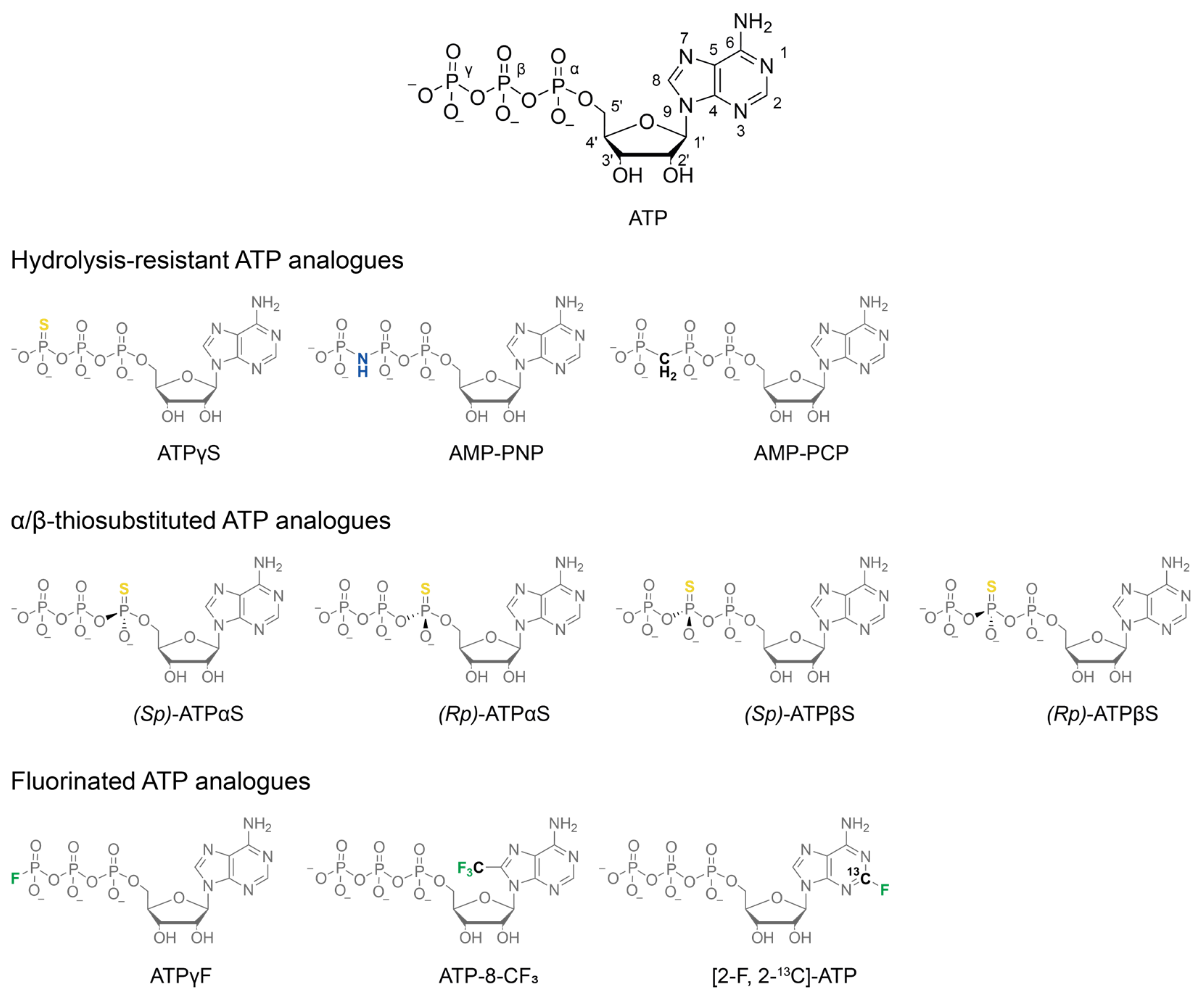



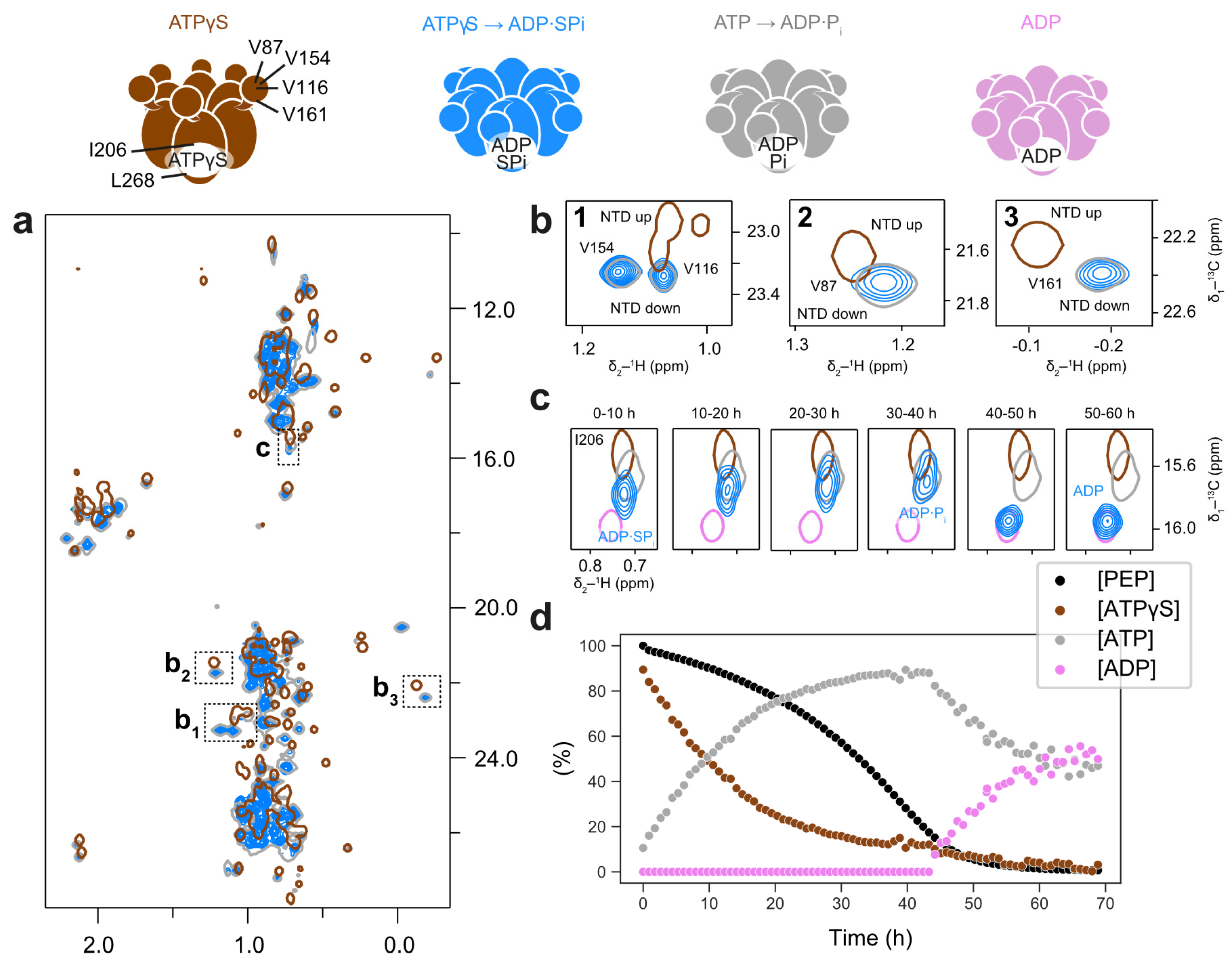
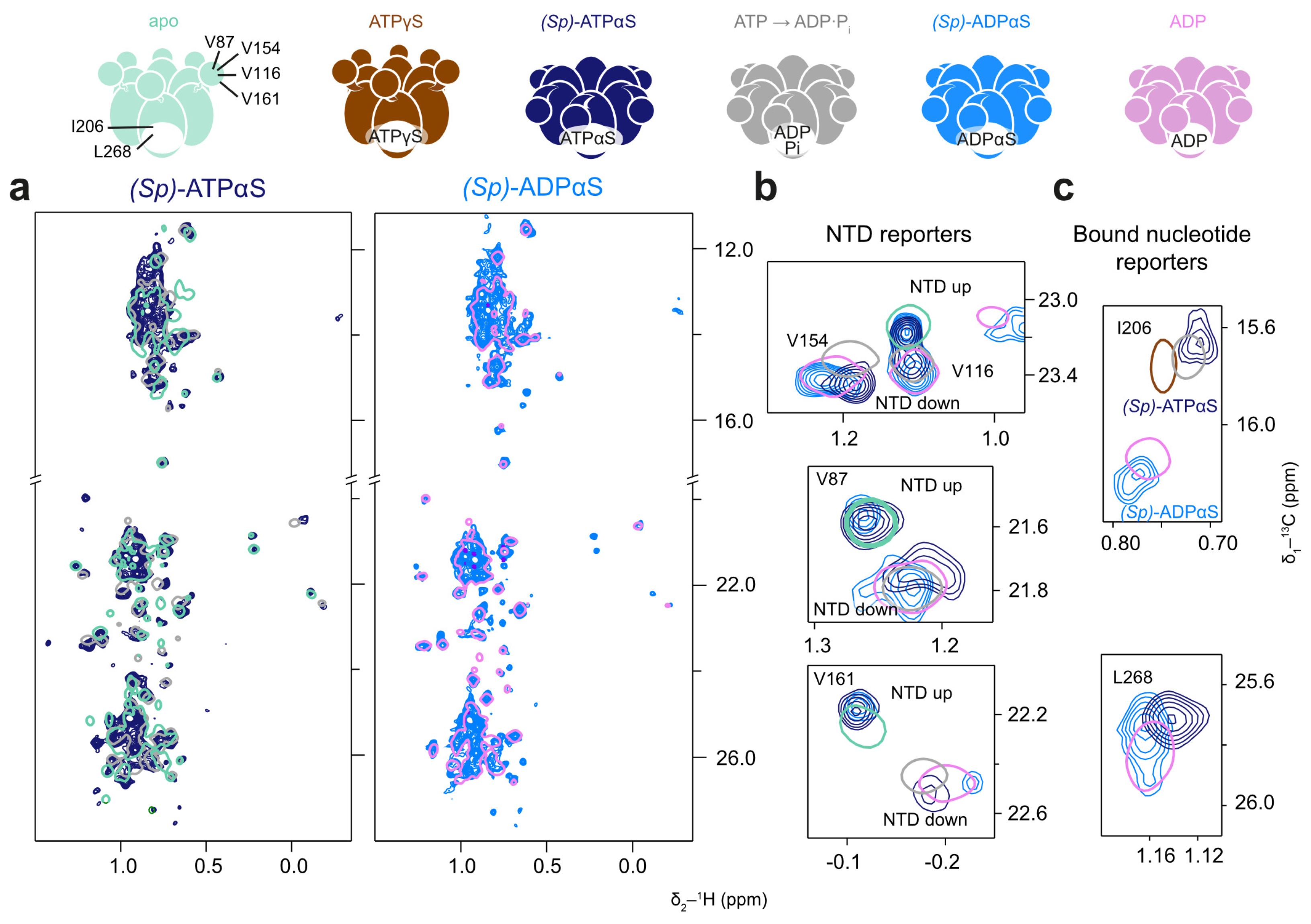

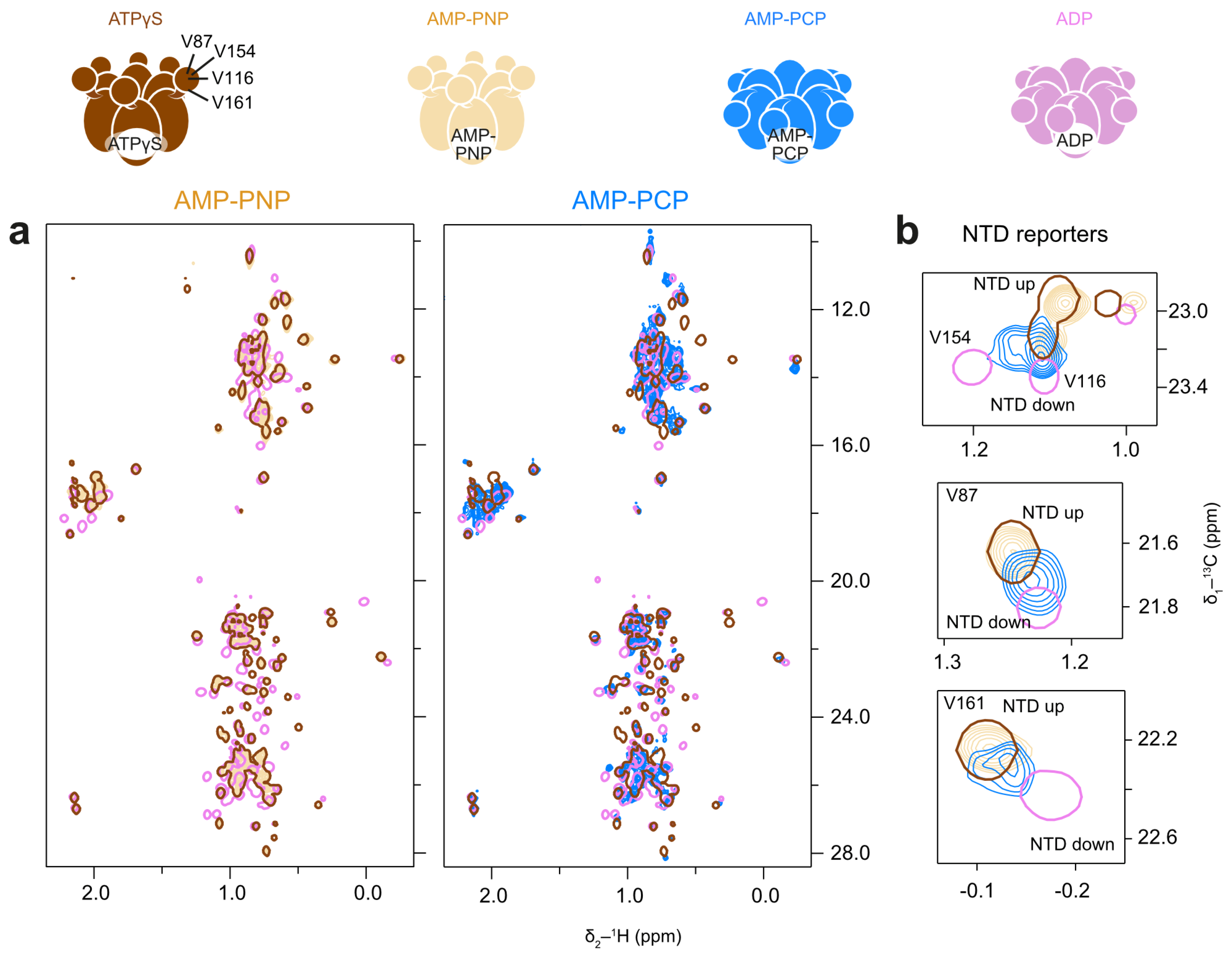
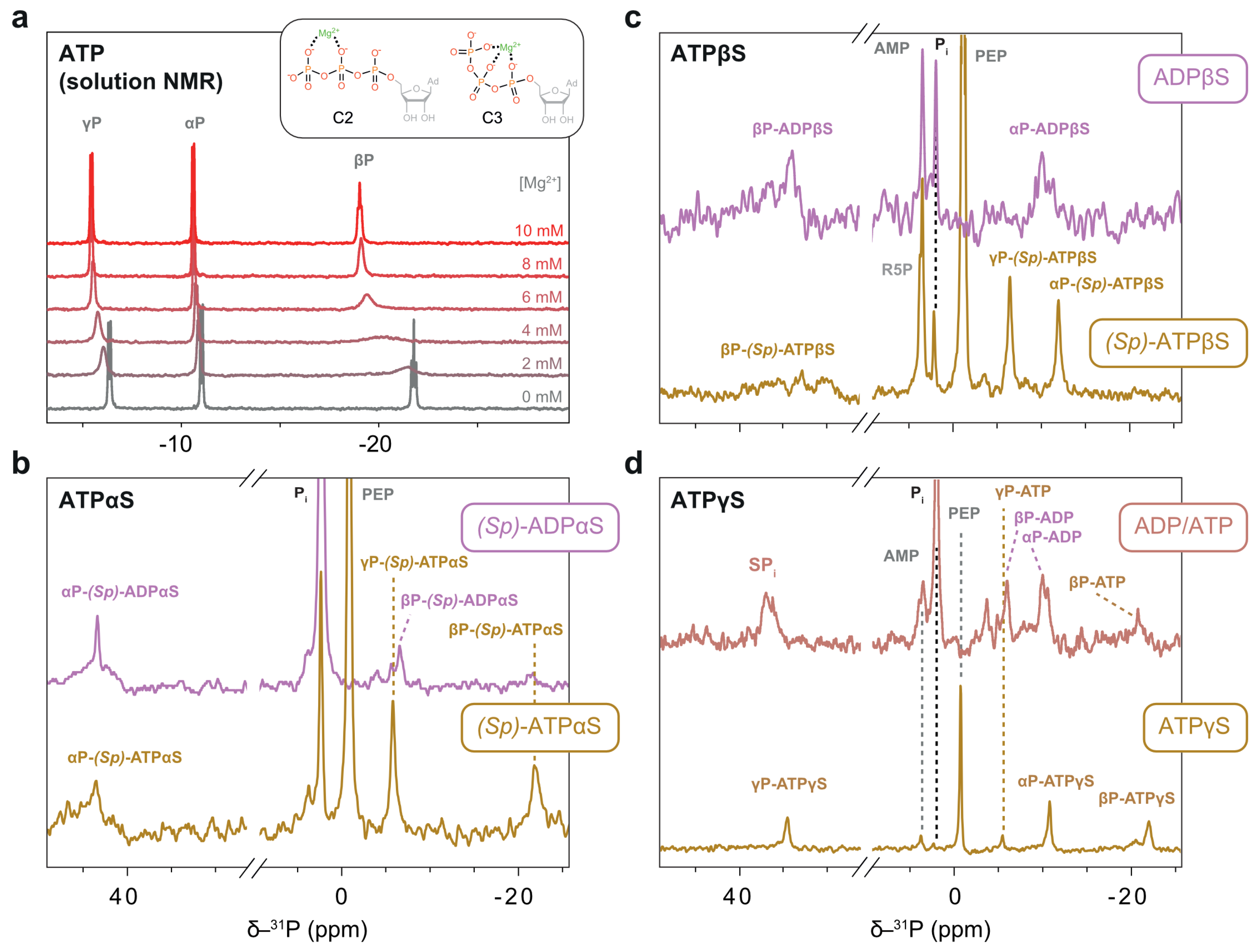

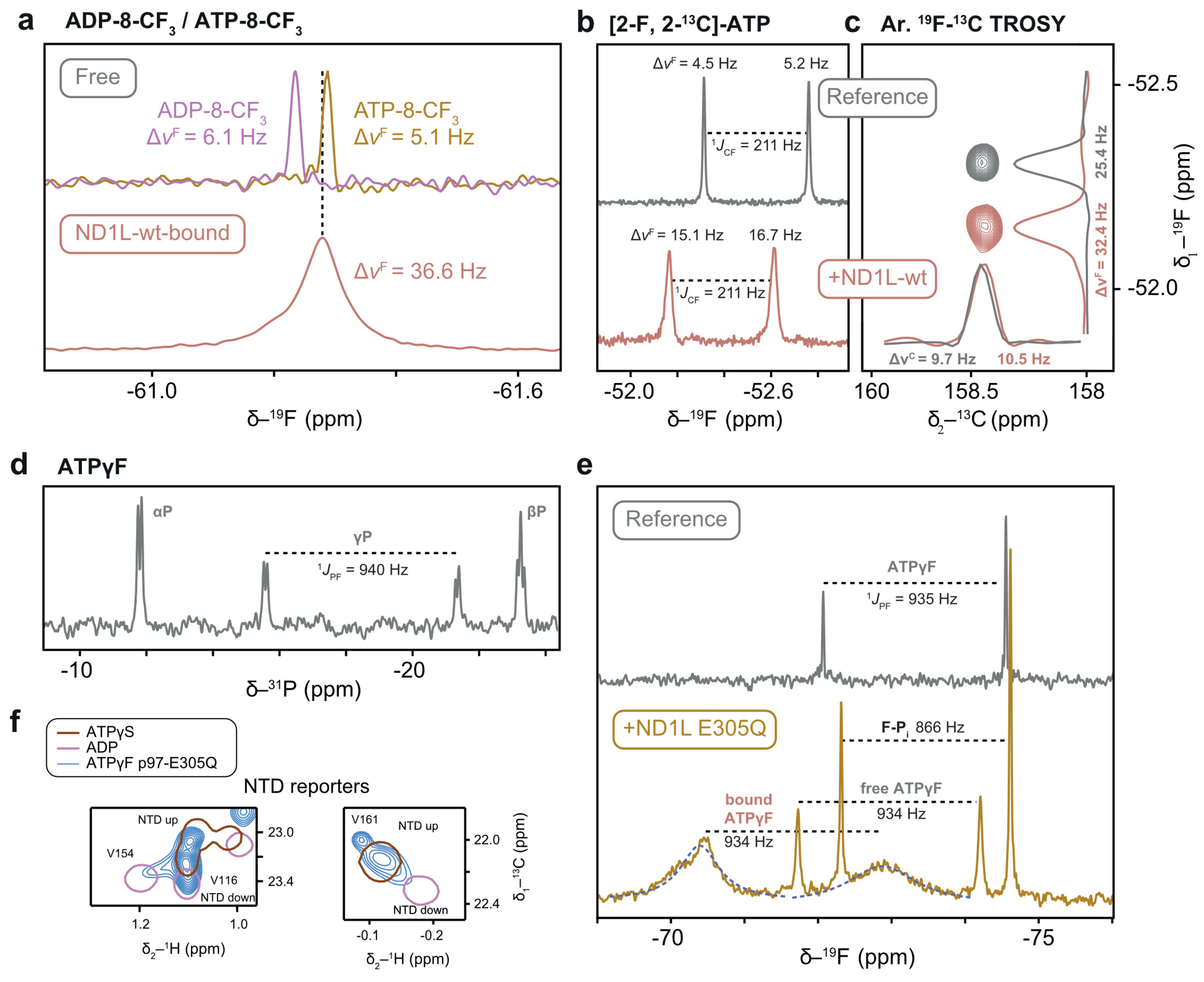
Disclaimer/Publisher’s Note: The statements, opinions and data contained in all publications are solely those of the individual author(s) and contributor(s) and not of MDPI and/or the editor(s). MDPI and/or the editor(s) disclaim responsibility for any injury to people or property resulting from any ideas, methods, instructions or products referred to in the content. |
© 2025 by the authors. Licensee MDPI, Basel, Switzerland. This article is an open access article distributed under the terms and conditions of the Creative Commons Attribution (CC BY) license (https://creativecommons.org/licenses/by/4.0/).
Share and Cite
Droemer, M.A.; Shein, M.; Schütz, A.K. Choice of ATP Analogues for Biophysical Studies—A Systematic NMR-Based Investigation for the AAA Enzyme p97. Biophysica 2025, 5, 9. https://doi.org/10.3390/biophysica5010009
Droemer MA, Shein M, Schütz AK. Choice of ATP Analogues for Biophysical Studies—A Systematic NMR-Based Investigation for the AAA Enzyme p97. Biophysica. 2025; 5(1):9. https://doi.org/10.3390/biophysica5010009
Chicago/Turabian StyleDroemer, Maxim A., Mikhail Shein, and Anne K. Schütz. 2025. "Choice of ATP Analogues for Biophysical Studies—A Systematic NMR-Based Investigation for the AAA Enzyme p97" Biophysica 5, no. 1: 9. https://doi.org/10.3390/biophysica5010009
APA StyleDroemer, M. A., Shein, M., & Schütz, A. K. (2025). Choice of ATP Analogues for Biophysical Studies—A Systematic NMR-Based Investigation for the AAA Enzyme p97. Biophysica, 5(1), 9. https://doi.org/10.3390/biophysica5010009





